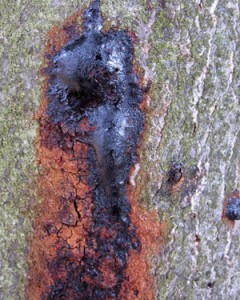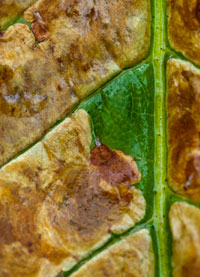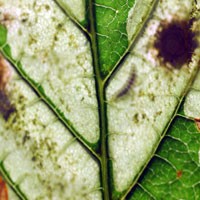Horse Chestnut : National Survey of Leaf Miner Moth

The woodland blog has been reporting on the various threats to the Horse Chestnut tree for some years: see blogs for May 2006, Aug 2006 , Sept 2008 and Dec 2009 . Basically, the tree is under attack by : -
Bleeding canker. The number of reports of bleeding canker on horse chestnut has significantly increased in recent years. The cause of the disease has now been established. It had been thought that the condition was due to a fungus-like organism. However, DNA analysis of damaged and diseased tissue has established the presence of a bacterium Pseudomonas syringae pathovar aesculi. The same bacterium is known to infect the Indian Horse Chestnut (Aesculus indica); it is possible that the bacterium was introduced on imported trees.
A leaf blotch fungus, or Guignardia aesculi . This attacks the leaves so that reddish or brown blotches with yellow borders develop. The blotches may, at a distance, look similar to the damage done by leaf miner
 The horse chestnut leaf miner moth, or Cameraria ohridella that lays its eggs in the leaves. The larvae that hatch from these eggs eat and tunnel their ways through the tissues of the leaves. In consequence, the leaves turn brown in early summer and may be shed from the tree.
The horse chestnut leaf miner moth, or Cameraria ohridella that lays its eggs in the leaves. The larvae that hatch from these eggs eat and tunnel their ways through the tissues of the leaves. In consequence, the leaves turn brown in early summer and may be shed from the tree.
The trees are weakened by these various attacks, losing vigour and vitality as the leaves use light energy to build up sugars and other materials for the plant’s growth and development.
This month a national survey is being launched to investigate the spread of this moth – visit the our web of life website for details about the moth, and also the small parasitic wasp that may help control the moth. Dr Darren Evans gives details of the survey, the moth and wasp in the BBC’s Material World program, which can be followed on the BBC iPlayer.
Comments are closed for this post.
Discussion
Sad to say the miners leaf moth blight appears to have struck the horse chestnuts in our local park at Driffield, East Yorkshire.
Unfortunatly my horse chestnut has developed this problem. I live in Huntingdon in Cambridgeshire. I was hoping that something had been found to treat them.
[…] Like silicon, it has been suggested that these metals serve to protect the plant against being eaten by herbivores but there is little evidence. Recent work with the Alpine Pennycress (Thlaspi caerulescens) suggests that such plants may gain some selective advantage in terms of resistance to infection by various pathogenic bacteria. Evidence for this comes from the work of Helen Fones, at Oxford University who has been growing the pennycress in different concentrations of zinc, nickel and cadmium and looking at infection by the bacterium Pseudomonas syringae. […]
Sad to say but nearly everywhere I look in Oxford, England – all trees seem to be affected by the leaf miner. I noticed the tree’s local to me where affected last autumn when this was brought to my attention on BBC Autumnwatch. This autumn it seems even worse when serveral trees are planted close together. When the tree’s are not close together the leaves are less affected.
I am not sure if Oxford is aware of this yet but if not – there is many tree’s here at risk. And so far from what I have seen they are all going to be affected by the leaf miner sooner or later.
Hope this helps.
I live in south Shropshire and I noticed maybe 2 years ago that the tree look lack lustre and thought at first it could be lack of water. Then I noticed all the leaves had White marks on then that turned golden brown exactly like the pictures illustrate. The tree is huge it’s been here since I’ve been living here ( 28 years)
I don’t no what to do as clearing the leaves up wen they fall is tricky as the tree is at the bottom of the garden and reaches over us, next door and over a stream beyond. I don’t want to cut it down. As the years roll on it looks worse :(
What do we do?
Kelly xx
I live west side of Wolverhampton and have been watching the leaf miner’s progress now for 3 years. All of the trees on my road have been affected by this, and each year the infestation seems to creep higher and higher up the trees. I feel that some of these tree are indeed a great age, and they are now looking two tone as there are only green leaves on the top half of the tree, and the ones below are brown. The outlying villages are also badly affected. I also note that Sycamores around and about have also been affected by this problem
I live in Leeds and have yet to pass one healthy looking horse chestnut tree so far this summer. Whilst in Harrogate last week, i noticed numerous horse chestnut trees in the same state of poor health.
The 60ft tree is now totally devoid of leaves & has black markings on the trunk. I think it has taken 2 yrs to die-the leaves were brown 2yrs ago & this year did not develop at all. I am in Coventry & considering getting it cut down
[…] of the horse chestnut leaf miner has been reported in the blog from summer 2006 to more recently, when a national survey was under way. This small, but highly efficient parasitic moth was first […]
When I first started filming the Tree ID DVD back in 2009, http://www.surviving-outdoors.co.uk/shop.html, I never came across the bleeding canker or the leaf minor. But last year 2010 did see evidence of the leaf miner here in Cornwall, but not so far this year on the same tree. I will check over the next week to see if the tree has any signs. Lets hope maybe the cold winter has diminished its spread!
?
The link works fine
Try http://www.forestresearch.gov.uk/fr/INFD-5UWFYB as an alternative
I still cannot get through to forestresearch and it is now 2011! The trunks of my many Chestnut trees do not seem to be too bad, but the leaves are already brown-blotched which is a lot earlier than in previous years. I am concerned that the conkers will not form – something the Sqirrels etc rely on during the winter. Can somebody help, please.
KILLED THEM ALL.
Ive had these moths growing in my leaves.
Ive noticed that the leaves in my local park have a very small moth in side the brown pockets created in the leaves, but the leaves in my own tree only have little brown magget looking things in.
ive managed to kill them all from my own tree by peeling open every pocket with my thumb and the sweezing the bugs inside untill puss come out of them to make sure there dead. as my tree is only 1 year old this only took 10 minits but dont know how long this method would take with a fully mature tree.
good luck.
The adult moths die, but the pupal stage survives the winter.
the life cycle is egg then larva or caterpillar, then pupa, then imago or adult.
The larval stage is a feeding stage (which does so much damage to the leaves) and the pupal stage is a stage in which the body tissues are reorganised into the adult form.
I have a 50 year old Horse chestnut tree in my garden. This is the third year of moth attack. This year the attack has been very bad.Where do the moths go in the winter, The moths a very small. and as we had a very cold winter I didnt expect them to survive through to the spring.Its a wonderfull mature tree.
The Forestry Commission offers some advice on the Horse Chestnut problems , for example see
http://www.forestresearch.gov.uk/website/forestresearch.nsf/ByUnique/INFD-6Q3DPF
Hi,
We have a stunning Horse Chestnut tree on our grounds which seems to have contracted the leaf fungus as i can’t see any canker on the trunk and no evidence of moth eggs.
From the info you give it sounds like the tree will recover from moth attack but will it eventually recover from leaf fungus or can we treat it to save it? Any advice would be much appreciated.
Went to Anglesey abbey gardens (NATIONAL TRUST) 9/08/2010 and the horse chestnut trees are in a very poor state with this disease, I was told the NT are to cut down all of the trees in the gardens (these number about 100 plus). Else where in Norfolk, I have seen tree after tree with brown leaves and the canker.
THE HORSE CHESNUTS IN BEAUTIFUL CARY PARK IN BABBACOMBE SOUTH DEVON, HAVE NOW FALLEN PRAY TO THIS BLIGHT WITH SMALL CONKERS FALLING AND LEAVES UNDER ATTACK TURNING BROWN.
I have 3 horsechestnut trees behind my property whihc have been like this for sometime. My garden is full of leaves and also some of my shrubs are now covered with these moths.
I have contacted my local Council Cotswold District Council, but am still awaiting a reply!
This might interest
http://www.sylva.org.uk/treewatch/about.php
All trees in our local park seem to be affected by leaf minor in a huge way. Baby conkers are falling and leaves look pale with blotches – but all of them. Have reported to parish council who hopefully will take it forward.
As of today, I cannot get any connection to their website to work – so will look again on Monday to see if it has been remedied.
Meanwhile,
http://www.physorg.com/pdf195478399.pdf
http://www.eppo.org/QUARANTINE/Alert_List/bacteria/Pseudomonas_s_aesculi.htm
and
http://www.danes-insects.org.uk/horse.htm
and http://en.wikipedia.org/wiki/Horse-chestnut_leaf_miner
might interest, pro tempore …..
Tues : all links now working again.
Chris
It appears that the links to http://www.forestresearch.gov.uk do not work, the cause maybe asa follows:
When the server, while acting as a gateway or proxy, contacted the upstream content server, the connection was refused. This usually results from trying to connect to a service that is inactive on the upstream server.
How can I get the information?


I have just moved to a retirement apartment in Bournemouth and there is a badly infected tree 20 feet from the block. It is clear that the lower branches have been removed but where the new leaves have aprouted, they have all become infected. There is a beautiful tree at the front of the property which is likely to be infected unless this one is cut down. I will be watching to see what the gardeners do when the leaves drop in Autumn!
Ann
4 August, 2012